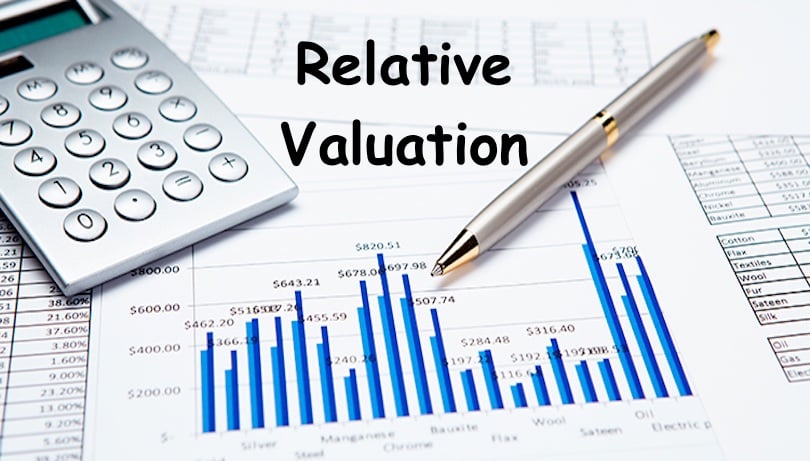Relative Valuation is an approach where an asset is valued not based on of its fundamentals (cash-flows, growth, and risk) but on the basis of what other people are paying for assets just like it. Hence, it is also called “pricing”. It is the way for how 90% of the valuations are done. Relative Valuation has 3 steps.
- Finding companies just like the subject company
- Standardizing prices. We cannot compare price per share because it is an arbitrary number. If the stock were to split, the price per share would halve. So we use a multiple. Dividing price by earnings or by book value, we obtain a standardized price.
- Controlling for those differences. The target company might still be different from other companies in terms of growth and risk in cash-flows which need to be adjusted for.
Relative Valuation
Any relative valuation considers a multiple comprising of a numerator and a denominator. In the numerator, we see one of 3 numbers – market value of equity (market cap), market value of the firm (market cap + market value of debt), or enterprise value (market cap + market value of debt – cash). The numerator always takes some measure of market value. With the denominator, we can divide the market value number by revenue or any of the drivers of revenue.
There are several advantages of using revenue, it being a positive number helping us to always being able to calculate the multiple. The drivers of revenue may be number of clients for subscription businesses, and such. We may also use a measure of earnings such as net income or operating income for equity and firm respectively. Similarly, we may use the cash-flows in the denominator, using FCFE or FCFF. We can also use the book value in the denominator, using book value of equity or of the firm.Using a multiple involves a 4-step process.
Defining the multiple.
The first check on a multiple is the consistency of its definition, i.e. if the numerator of the multiple is an equity value, the denominator has to be an equity value as well. Same goes for firm / enterprise values. The second check should be on the uniformity of estimation of the multiple. If we are using multiple values of 15 firms, we need to be measuring the same thing. A common multiple used is the price-to-earnings ratio. However, the “earnings” portion of that multiple is an accounting number and we know the same accounting standards may result in different degrees of fidelity to those standards.
The PE may use the earnings from the most recent financial year or the trailing twelve months. The earnings could be before or after the extraordinary items. The earnings may be primary, partially diluted, or fully diluted. What analysts use is simply the story they’re trying to sell. Similar problems persist with other widely used ratios such as EV/EBITDA. Accounting numbers pose a threat that companies with conservative estimates of earnings look expensive and aggressive ones look cheap.
Describing the multiple.
This is an analysis where we find the basic statistical data like average and standard deviation. Most multiple data is asymmetrical. Most ratios such as PE, EV/EBITDA are positive for healthy companies. So the minimum is pegged to zero. But PE ratios may be as high as 100 or even 300 for some companies due to which the averages get pulled out by large positive outliers. Hence the median makes more sense while talking about a multiple. Also, when such ratios are negative, we need to drop the companies from our data-set. As of 30 Nov 2018, 21% of Indian listed companies had a negative PE ratio. That’s losing a lot of data. Also, we are creating a bias in the sample by ignoring the smallest, riskiest, and most troubled companies.
Drivers of multiple.
The questions we’re trying to answer here are (a) what are the variables that determine this multiple and (b) how does the change in those variables change the multiple. Again taking PE ratios as an example. We know that high growth companies have high PE ratios. So what is the change in PE for a 1% change in growth? If we can’t answer this question, then we cannot scale our multiples for our specific companies. The simplest way to do that is to use a stable growth dividend discount model for determining the price, and then substitute the mathematical term for the price in the relative valuation multiple.
Apply the multiple.
To apply the multiple we need to find out the comparable companies. The lazy way of doing this is to compare companies in the same sector. Reliance is a refinery but is there any refinery company that is remotely close to Reliance? From a valuation perspective, a comparable company is one with similar cash flows, similar growth, and similar growth. There is no need to consider a sector. However, no matter how careful are, there will be differences between the target company and sample companies. We need to find creative ways of controlling for those differences. For example, since high growth companies have high growth rates, we may divide the PE ratio by the growth rate which is called the PEG ratio.
So one needs to be creative about Relative Valuation. Don’t just compare multiples with the average for the sector. We need to consider the data, look across the sector, and not throw away information. Some statistical analysis enables us to make better judgments about why differences in companies translate into differences in multiples. If we’re able to do that, multiples are excellent tools to have in the arsenal.
Must Read
